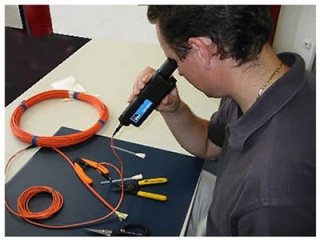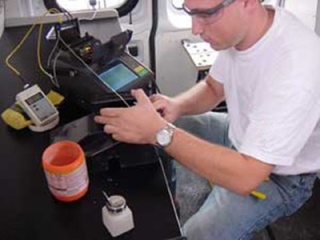Be Careful When Working With Fiber Optic Cable
srijeda , 20.07.2016.It’s known that safety issues or hazards are commonplace in both copper and fiber cabling installation, faced by installers. And when it comes to this topic, many people think that copper cabling installation need more attention and caution, since they carry electricity. In comparison, optical fibers are safer because of the light they carry. But actually, this concept is misplaced. As to fiber optic cables, whose ends are capped with the same or different connectors (e.g. ST ST fiber cable and LC to SC cable), they carry data in the form of light which can bring harms to the eyes.
Many people are unaware of the problems that fiber poses. Some installers don’t think much of fiber optic issues, and they don’t take proper safety precautions to avoid the many hazards that can be caused by fiber optics. Working with fiber optic cables needs much caution, and installers need to do the two points for safety: fiber fragment disposal and eye protection.
Fiber Fragment Disposal
When an installer is trimming, stripping, or cutting fibers, tiny fragments may fall where it will--on the top of the table where the job is being done, at the bottom of the raised floor, or maybe into a cup of coffee that is close by. The scraps may even be brushed into a nearby garbage can. Then what happens if someone rests his or her hand on top of that fiber scrap? The glass is transparent and the scrap is probably small, so unless the person is the one who did the terminating, he or she may not know the hazard is there. Because of this, workers should not eat or drink in a fiber optic work area since a fiber scrap could fall onto their food or in their drink.
It’s important to keep in mind that tiny fiber fragments can penetrate the skin and become embedded, causing a serious irritation. Ingested fibers can cause internal damage since they are light enough to float in air.
To avoid such potential danger, these safety kits can be used:safety glasses (for keeping eyes free of scraps), a black polishing/work mat (the black surface makes it easier to locate fiber scraps), Teflon-coated tweezers to remove splinters (regular tweezer ends break fiber scraps), and a bifurcated swipe (for cleaning fiber ends and sterilizing the tweezers for splinter removal). One of the most popular components of the kit is the fiber-scrap trash can, which provides a single place for disposing of bits of fiber. Once full, the small trash can may be incinerated.
Eye Protection
After finishing cable installation, many installers unfamiliar with fiber-optic technology may look at the fiber’s end to verify that light is being transmitted, which causes the loss of visual acuity or blind spots because the beam is focused on the retina. What’s even worse is that the light used in fiber- optic communications systems is in the infrared range and is not visible to the human eye.
So when working with fiber optics, all workers performing any splicing or termination activities should always wear safety glasses with side shields. Any other people or site managers entering the work area should wear safety glasses with side shields also. Unless an installer is absolutely sure there is not a light source at the other end, they should never look directly into the end of the cable. A power meter can be used to make certain the fiber is dark.
Other Safety Considerations
Chemicals: Fiber optic splicing and termination use various chemical cleaners and adhesives as part of the processes. Normal handling procedures for these substances should be observed. Even simple isopropyl alcohol, used as a cleaner, is flammable and should be handled carefully. Manufacturers will supply "material safety data sheets" (MSDS) on request or they may be found on the Internet.
Splicing hazards: Fusion splicers use an electric arc to make splices, so care must be taken to insure no flammable gasses are present in the space where fusion splicing is done.
No Smoking: Smoking should also not be allowed around fiber optic work. The ashes from smoking contribute to the dirt problems with fibers, in addition to the possible presence of combustible substances (and, of course, the health risks.)
Safety Tips
While working with fiber optics, the worker needs a well-ventilated and well-lit work area. Workers must avoid smoking while working with fiber optics.
Also, all food and beverages should be kept out of the work area. Workers can wear disposable aprons to keep fiber particles off their clothing. Before leaving the work area, an employee should always check their clothing for pieces of stray fiber, and if any are found, they can remove it with double-sided tape.
A worker should wash their hands thoroughly before touching their eyes, and contact lens wearers should wash their hands before touching their lenses. Workers should also read all instructional material before handling chemicals.
A disposable container that can be tightly closed must be used for fiber scraps. When finished with a fiber optic job, all cut fiber pieces should be disposed of properly along with any used chemicals and containers. The work area should be thoroughly cleaned when job is completed.
Conclusion
Understanding the potential dangers and knowing the simple fiber optic safety tips can keep the working environment clean and safe for workers, so as to avoid hazards. As an outstanding fiber patch cord manufacturer, Fiberstore supplies various kinds of fiber optic cables for your cabling installation, test- and quality-assured. You can have a try here.
Oznake: fiber optic cables, ST ST fiber cable, fiber cabling installation, fiber fragments, eye protection, fiber patch cord manufacturer
komentiraj (0) * ispiši * #
Learning Five Ways to Test Fiber Optic Cables
srijeda , 29.06.2016.In this technological world filled by fiber optic systems everywhere, one won’t fail to enjoy the benefits brought by fiber optics in daily life. In a whole fiber optic system, the most essential part should be the fiber optic cable. This cable is made up of incredibly thin strands of glass or plastic capped with the same (eg. ST ST fiber cable) or different connector types (LC ST patch cable) on the ends, used as the medium to carry information from one point to another with light-based technology. Just like electricity that can power many types of machines, beams of light can carry many types of information, so fiber optics do great to people in many ways, like broadcasting, transportation, medicine, etc..Along with the heavy use of fiber optic cables, testing the installed cables also gains importance in practical use. Since there are many standards available for testing, some people may get confused. But don’t worry. This text is written with an attempt to clear off this confusion.
Testing Principles
Generally speaking, five ways are listed in various international standards from the EIA/TIA and ISO/IEC to test installed cable plants. First three of them use test sources and power meters to make the measurement, while the last two use an optical time domain reflectometer (OTDR). Let’s first see the different results from these methods, and then delve into each one.
The use of source and power meter method, also known as “insertion loss”, simulates the way the actual network uses the cable plant. The test source mimics the transmitter, and the power meter the receiver. But insertion loss testing requires reference cables attached to the source and meter to connect to the cable under test. This insertion loss test can use 1, 2 or 3 reference cables to set the “zero dB loss” reference for testing. Each way of setting the reference gives a different loss. While OTDR is an indirect method, using backscattered light to imply the loss in the cable plant, which can have large deviations from insertion loss tests. OTDRs are more often used to verify splice loss or find damage to cables.
Source/Power Meter Method
In source and power meter method, all the three tests share the same setup (shown below), but the reference power can be set with one, two or three cables as explained next. In general, the 1 reference cable loss method is preferred, but it requires that the test equipment uses the same fiber optic connector types as the cables under test. If the cable (ST ST fiber cable) has different connectors from the test equipment (SC-SC on the tester), it may be necessary to use a 2 or 3 cable reference, which will give a lower loss since connector loss is included in the reference and will be subtracted from the total loss measurement.
Reference per TIA OFSTP-14 (1 Cable Reference)
This method, formerly called method B, uses only one reference cable. The meter, which has a large area detector that measures all the light coming out of the fiber, effectively has no loss, and therefore measures the total light coming out of the launch reference cable. When the cable is tested as below, the measured loss will include the loss of the reference cable connection to the cable plant under test, the loss of the fiber and all the connections and splices in the cable plant and the loss of the connection to the reference cable attached to the meter.
Reference per TIA OFSTP-14 (2 Cable Reference)
This one, formerly called method A, uses two reference cables with one launch cable attached to the source, and the other receive one attached to the meter. (The two cables are mated to set the reference.) Setting the reference this way includes one connection loss (the mating of the two reference cables) in the reference value. When one separates the reference cables and attaches them to the cable under test, the dB loss measured will be less by the connection loss included in the reference setting step. This method gives a loss that's less than the 1 cable reference.
Reference per TIA OFSTP-14 (3 Cable Reference)
Reference cables are often patch cords with plugs, while the cable under test has jacks on either end. The only way to get a valid reference is to use a short and good cable as a "stand-in" for the cable to be tested to set the reference. To test a cable, replace the reference cable with the cable to test and make a relative measurement. Obviously this method includes two connection losses in setting the reference, so the measured loss will be less by the two connection losses and have greater uncertainty. Finally, here goes the picture showing the testing case with one, two, three reference cables.
OTDR Testing
With only one lunch cable, the OTDR can measure the length of the cable under test and the loss of the connection to the cable under test plus the loss of the fiber in the cable under test, and any other connections or splices in the cable under test. However, this method doesn’t test the connector on the far end of the cable under test, because it isn’t connected to another connector, and connection to a reference connector is necessary to make a connection loss measurement.
If a receive cable is used on the far end of the cable under test, the OTDR can measure the loss of both connectors on the cable under test as well as the fiber in the cable, and any other connections or splices in the cable under test. The placement of the B marker after the connection to the receive cable means some of the fiber in the receive cable will be included in the loss measured.
Conclusion
Hope this article is helpful for you to understand various methods existing to test fiber optic cables. For more information about testing methods or testing tools, you can directly connect me at Linkedin@Fern Xu (Fiberstore).
Oznake: fiber optic cable, LC ST patch cable, ST ST fiber cable, cable testing methods, source and power meter, OTDR
komentiraj (0) * ispiši * #







